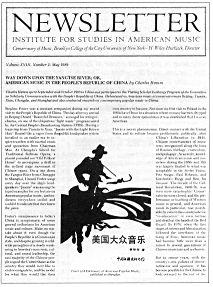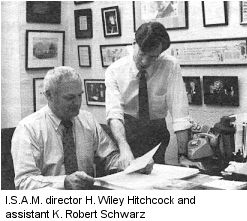The Institute for Studies in American Music At Brooklyn College
by H. Wiley Hitchcock
The Institute for Studies in American Music at Brooklyn College of the City University of New York was established in 1971. Most people give me credit for initiating I.S.A.M., but in fact it was the brainchild of Sherman Van Solkema, then chairman of the college's music department, although it's true that he was sparked by a 1968 article of mine in the journal Notes, in which I urged action by scholars to combat the neglect by the musicological establishment of American-music studies, not to say its disdain for them. (A notorious expression of that attitude was Joseph Kerman's, at the 1964 meetings of the American Musicological Society: "The student of Beethoven [or] Marenzio or Louis Couperin is concerned with music that can be brought to life; but Francis Hopkinson or Lowell Mason or Theodore Chanler [and here Kerman had cunningly chosen composers from the three centuries of American music]-surely they would defy all efforts at resuscitation. Man, they are dead.")
Van Solkema — an old friend from our graduate school days together at the University of Michigan — had a characteristically bold, visionary reaction to my article (and was perhaps encouraged by my 1969 book, Music in the United States): he persuaded Brooklyn College's president that a research and information center focused on American music was needed, and then persuaded me to transfer from Hunter College, join the music faculty at Brooklyn College, and become director of the new center.
Thus was I.S.A.M. born, with a firm commitment from the college (which has maintained it through thick and thin) and initial extra support from The Rockefeller Foundation. Its goals were expressed, in somewhat lofty language, in a brochure announcing the institute:
The basic function of the Institute is to provide a suitable academic framework in which to encourage, support, propagate, and evaluate research in music of the United States-past and present, cultivated and vernacular, classical and pop, jazz and rock, white and black, inner-American and inter-American.
Lofty language or not, those multiple goals of I.S.A.M., in a context of affection and respect for all American musics, have been pursued throughout the eighteen years of the institute's existence ... and apparently with some success: one wall of the I.S.A.M. offices is covered with framed tributes to the work of the institute-from the American Music Center, ASCAP, the British Library Association, the (American) Music Library Association, the Sonneck Society for American Music, and other organizations.

The institute contributes to American-music studies by publishing monographs, bibliographies, and discographies, as well as a periodical newsletter; by soliciting and helping to prepare manuscripts for the series of musical editions RECENT RESEARCHES IN AMERICAN MUSIC (published by A-R Editions, Inc., of Madison, Wisconsin); and by sponsoring research fellowships, concerts, colloquia, and conferences. Institute staff have also been involved in Da Capo Press's facsimile-reprint series EARLIER AMERICAN MUSIC, and the institute has accepted assignments for investigative surveys and research projects from such entities as the National Endowment for the Arts and the Koussevitzky Music Foundation. In the early 1980s, the institute, especially its director, was occupied (not to say preoccupied) with research and editorial assistance to Macmillan Publishers towards the unique four-volume New Grove Dictionary of American Music (1986). Finally, the institute is the administrative home of the Charles Ives Society, Inc. (of which I happen to be president).
Over the long haul, the publication program of I.S.A.M. has loomed largest in its activities. This includes a biannual Newsletter, research-oriented monographs (some brief, others book-length), and various kinds of special publications.
The biannual Newsletter has gradually become a kind of mini-magazine (rather than a house organ), with feature articles (in the current issue, for example, Charles Hamm's "Way Down Upon the Yangtse River; or, American Music in the People's Republic of China [see illustration] and Wayne D. Shirley's "Once More Through The Unanswered Question," which reveals the source of Ives's title in a poem by Emerson); regular columns (Mark Tucker's "Behind the Beat" on jazz and rock, Charles Wolfe's "Country and Gospel Notes"); book, record, and score reviews; and items of news and information. The Newsletter is distributed gratis to a mailing list of almost four thousand.

I.S.A.M. monographs now number twenty-eight, with several more in various stages of production. The variety of their subjects may be suggested by a few titles: The Music of the Bay Psalm Book; The New Worlds of Edgard Varese; A Tale of Two Cities: Memphis Rock and New Orleans Roll; The Music of Henry Cowell: A Descriptive Catalog; From Print to Plastic: Publishing and Promoting America's Popular Music (1900-1980); Ives: A Survey of the Music; and Reflections and Research on Ragtime. Their authors have included not just musicologists of distinction (Gilbert Chase, Irving Lowens, Vivian Perlis) but also composers (Roger Reynolds, Bruce Saylor), critics (Robert Palmer), librarians (Richard Jackson, William Lichtenwanger), a music-industry figure (Russell Sanjek), and a magazine editor (Minna Lederman).
Special publications of I.S.A.M. worth particular mention include Carol Oja's massive, unique discography of 20th-century U.S. concert music (American Music Recordings) and Richard
Jackson's U.S. Bicentennial Music, listing works composed or reprinted especially for the U.S. Bicentennial. The institute's own Bicentennial project was American Music Before 1865 in Print and on Records, a biblio-discography that proved useful enough to go out of print (!) but is now being revised and updated for republication. I.S.A.M.'s only straight reprint publication so far is a facsimile of the hilarious Physiology of the Opera of 1852, a satirical spoof by "Scrici" (an Italianate pseudonym, to be pronounced "Screechy").
I.S.A.M. has sponsored two major conferences —one (with Yale's School of Music as co-sponsor) a five-day all-Ives affair built around the composer's centennial in 1974, the other a three-day centennial investigation in 1977 of "The Phonograph and Our Musical Life"-and many smaller ones, usually with concerts attached. With the development of Brooklyn College's music department into a full-fledged conservatory, the institute's concert-sponsoring activity declined, but we recall with pride our very first concert, back in 1972-"A Ragtime Jamboree" (with six pianists, including the late Eubie Blake), well before the ragtime revival took off-and other memorable ones including the first public recital, as a team, of Joan Morris and William Bolcom; a choral turn by Neely Bruce's now-legendary American Music Group, from the University of Illinois; and solo appearances by William Warfield, John Cage, Yvar Mikhashoff, and Pauline Oliveros.
The Rockefeller Foundation helped Brooklyn College get used to the idea of visiting scholars of American music, with generous grants that allowed I.S.A.M. to bring to the college, as teachers and lecturers, luminaries in various fields-early American music (Irving Lowens, Richard
Crawford), American musical theater (Robert Kimball, Eric Salzman, Thomas L. Riis), jazz (Dan Morgenstern, Martin Williams, James Lincoln Collier), pop and rock (Robert Palmer, John Rockwell, Charles Hamm), country music (William Ivey), ragtime (EdwardA. Berlin). (Since 1977, the college itself has supported this program.) I.S.A.M. views living composers as a very special kind of scholar, and a number have been in residence: Robert Ashley, William Brooks, Pauline Oliveros, Roger Reynolds, Morton Subotnick. Besides directing student seminars, all these scholars have also delivered public lectures, most of which, edited for publication, are in print as I.S.A.M. monographs.
I.S.A.M. was established in the conviction that there was a real need for encouragement of American-music studies and for a hospitable academic environment in which to nurture them. It would be foolish to suggest that those needs no longer exist. But there has been a real change within the American scholarly world vis-à-vis American music as a field of study, and the Americanists who pursue it. Not only did the mid-1970s see the establishment of a scholarly society specifically dedicated to American music-the Sonneck Society (named after a great early Americanist, Oscar Sonneck, first chief of the Library of Congress's Music Division and first editor of The Musical Quarterly); the early 1980s saw the august American Musicological Society electing as its president, for the first time in its history, an out-an-out Americanist (Richard Crawford); the A.M.S. even appointed a new "Committee on the Publication of American Music" to plan a long-term, open-ended series of critical editions of American music. (Under grants from the National Endowment for the Humanities, work has begun on this series, to be called MUSA—MUSIC OF THE UNITED STATES OF AMERICA.)
Richard Crawford put it succinctly in his valedictory address upon stepping down as president of A.M.S. — an address titled "Studying American Music" which was happily published by I.S.A.M. as its Special Publication No. 3 (1985): "Studying American music, a slightly eccentric pastime for a musicologist not so long ago, now seems more and more like a perfectly natural thing to do." The I.S.A.M. at Brooklyn College cannot, of course, take the credit for this development, but it has helped, and we at I.S.A.M. are understandably delighted about it.
Musicologist and editor H. Wiley Hitchcock is Director of the Institute for Studies in American Music at Brooklyn College.
|